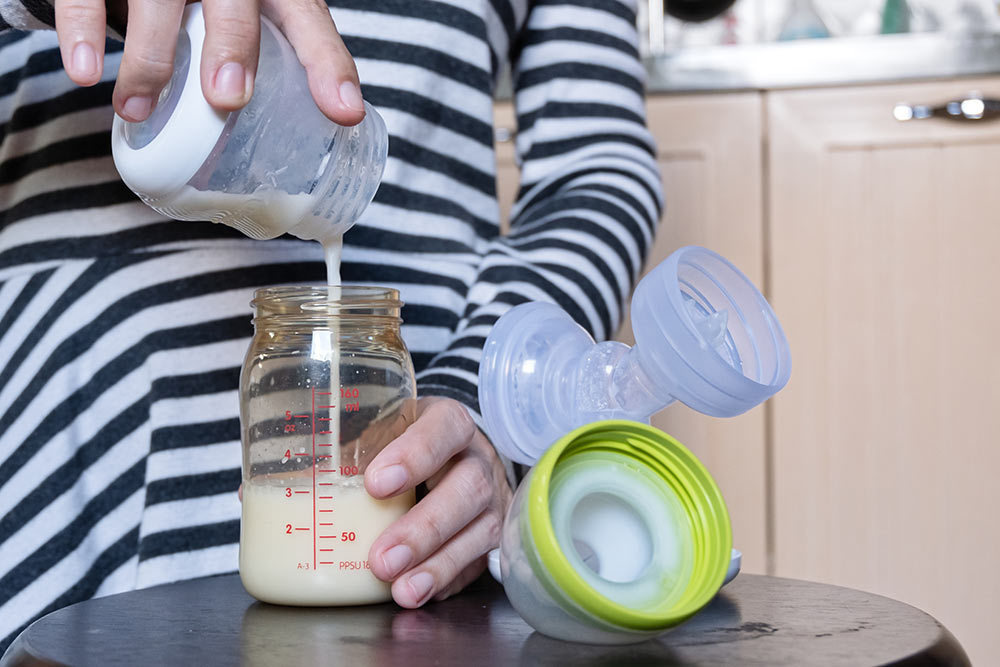Can You Mix Breast Milk From Different Days? Experts Explain

What to know about combining milk from different pumping sessions—including how to do it safely.
There’s a reason they call breast milk liquid gold—it is full of nutrients for babies, and a parent’s actual blood, sweat, and tears often go into nursing, pumping, and expressing it. Given how precious it is, it’s understandable why so many parents are curious whether or not they can mix breast milk from different days into one bottle. After all, the last thing anyone wants is to watch their hard work go to waste.
Despite all of the health benefits of breast milk, it can quickly spoil due to bacteria, so it’s reasonable to be cautious or question the safety of mixing breast milk from different pumping sessions. We spoke to Elizabeth Cilenti, MD, MPH, a pediatrician practicing in Arlington, Virginia; Tanya Altman, MD, FAAP, a pediatrician practicing in Los Angeles and medical consultant for Ember Baby Bottle System; and Jenelle Ferry, MD, a neonatologist and director of feeding, nutrition, and infant development at Pediatrix Neonatology of Florida, to help shed some light on this topic.
How Long Can You Store Breast Milk?
According to the Centers for Disease Control and Prevention (CDC), proper breast milk storage is essential to avoiding bacterial growth and ensuring baby’s safety. However, safe breast milk storage guidelines vary based on where you’re tucking the milk away when it’s not in use.
“Many factors affect the length of time milk can be safely stored, including cleanliness during expression and fluctuations in temperature of the storage location,” explains Dr. Ferry.
Freshly pumped milk or expressed breast milk is safe for up to four hours at room temperature, and any leftover milk from a bottle needs to be fed to your baby within two hours; otherwise, it should be dumped out (regardless of whether it’s fresh breast milk or if it had been stored previously).
Dr. Altman says a container of breast milk can be safely stored in the refrigerator for four days. You can also freeze some of your milk supply for future use. Dr. Ferry explains that safe freezer storage guidelines are based on the type of freezer you have. “In a freezer compartment inside a refrigerator (not a separate freezer), breast milk can be stored for two weeks; in a freezer that is separate but attached to a refrigerator and zero degrees Fahrenheit, six months; and in a deep freezer at -4 degrees, 12 months.” Finally, frozen breast milk that has been fully thawed in the refrigerator is safe for 24 hours, and thawed breast milk at room temperature is good for two hours.
When freezing, Dr. Ferry recommends storing milk in small amounts—between 2 to 4 ounces—to avoid waste after thawing. Additionally, she says it’s best to keep the milk in the back of the refrigerator or freezer, not inside a compartment on the door.
Can You Mix Breast Milk From Different Days?
Our experts agree that you can mix breast milk from different days. In fact, Dr. Altman says, “This is very common when baby needs to eat more than what is produced in one pumped serving.”
That being said, some safety measures should be taken when mixing breast milk.
“Cool the freshly expressed milk before combining it with already refrigerated or frozen milk so that it doesn’t warm up the older milk,” says Dr. Cilenti. She adds, “You should follow the storage recommendations of the [oldest milk in the mix],” so, for example, if you’re adding freshly expressed milk to a storage container that’s already been placed in the fridge, “the four days rule applies to the earliest expressed milk.”
Dr. Ferry echoes this and stresses the importance of labeling the milk storage bag (or bottle) with the date and time of the earliest expressed milk. To avoid confusion, she recommends storing milk from each day separately.
What Are Some Advantages of Mixing Breast Milk From Different Days?
While Dr. Cilenti says there aren’t any nutritional advantages to mixing breast milk from different days, there are still some other benefits the experts say come from this practice.
“In cases where [the nursing parent] has been sick or [they] potentially ate a food that seemed to irritate the baby’s digestion, mixing milk from different days may provide some benefit to baby,” says Dr. Altman.
Primarily, the benefits of combining milk like this tend to be more practical. Dr. Ferry explains that for parents who are exclusively breastfeeding and working to build their supply up for their return to work, mixing milk from different sessions (or days) may help ensure there is enough for a full day’s worth of bottle feeding when the parent and baby are separated. Additionally, Dr. Cilenti notes, “If you only have a small amount of expressed milk, [mixing it] can save space and reduce waste” (especially if it means you’re using fewer breast milk storage bags).
Whether or not you combine breast milk from different days, all three experts stress the importance of keeping everything clean and sanitized. “Always wash hands [and] use a clean area to pump and store breast milk,” says Dr. Altman. As an extra tip, Dr. Ferry explains, “Refrigerated breast milk or frozen breast milk may look or smell different than fresh breast milk, and that’s OK. Thawed breast milk, in particular, may look or smell soapy because of the breakdown of fats; parents can sometimes worry this means the milk has gone bad, but it is, in fact, safe to drink.”
Finally, don’t be afraid to reach out to your pediatrician or a lactation consultant if you’re struggling with breastfeeding—whether it’s building up your supply, learning how to properly clean your breast pump and parts, or if you have specific questions about storage. There is so much for new parents to remember, so take advantage of the resources available.








